- 30 May 2015
- Asia
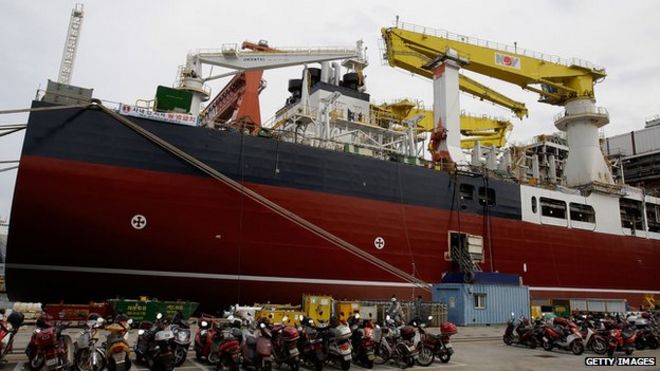
To a European visitor, the city of Ulsan on the southern tip of the Korean peninsula seems like a throwback to some lost world.
At first, it is hard to say exactly why. It is just that something doesn't feel quite right. Ulsan feels like a place you vaguely know but can't quite figure out how.
And then it hits you. It is reminiscent of old photographs of European shipbuilding towns on rivers whose names are redolent of their history: in Britain, the Clyde, Tyne, Wear, Tees or Mersey.
In those pictures cranes and partly built ships towered over houses. Thousands streamed from work together the moment a shift ended.
Nobody could forget how work enabled their lives because they saw, heard and smelled the place of work in every corner of the town. It was their skyline.
Asian domination
That world of the heaviest of industry is no longer prominent in Europe. Even the biggest shipyards that remain (in Romania, Poland and Germany) are minnows compared to the yards of Asia.
If you look at the league table of shipbuilding companies in the world, five of the top 10, including all of the top four, are South Korean. The other five are Japanese and Chinese.
But the Hyundai Heavy Industries yard at Ulsan is the biggest of them all, giant cranes (aptly called Goliaths) dominating the skyline. The city pulsates with work and wages and the activities of far from idle hands.
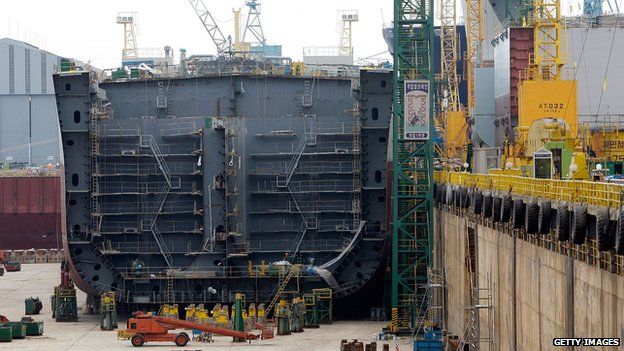
The yard stretches for 2.5 miles (4km). More than 60,000 people are employed there, constructing a huge ship every four or five days. These ships are the length of three football fields and are built in pieces each weighing hundreds of tonnes and then assembled around the clock.
A life's work
In the dark, the yard glows across the town. By day, the clang of construction rings out. In the old European pictures and newsreels, workers would stream home on foot or maybe bicycles. At Ulsan, they swarm out on motor scooters.
And when they are out, they drive the company car, eat in the company restaurants, laugh and cry in the company theatre, shop in the company department store, have their children in the company hospital, learn in the company schools, cheer for the company football team.
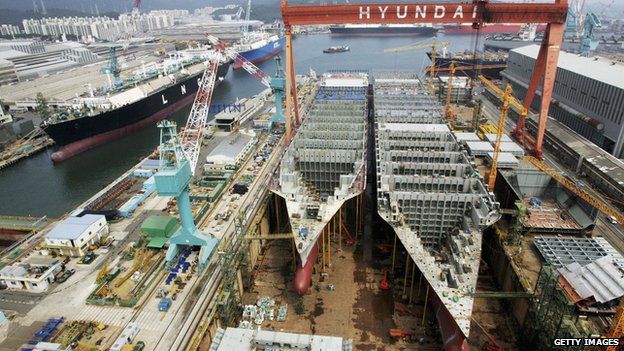
One of the longest-serving workers, Lee Sang-bok, told the BBC: "Everything here is Hyundai. The highway I drive on is named after the founder of the company. The hospital and university is funded by Hyundai too.
"There's a town joke that it's just like the Hyundai Kingdom."
He started work at the yard soon after it opened in 1974.
"I joined this company when I was just 16. In the past 40 years, shipbuilding really has become the centre of my life. I devoted all my youth to this company. It's become my identity".
'Directed capitalism'
When South Korea industrialised in the 1960s and 1970s, setting in train its breathtaking transformation from poverty to affluence, it was done in a way to make Western "free-market" economists disapprove (though there is an argument that when the United States and Britain industrialised, they broke their own rules, too).
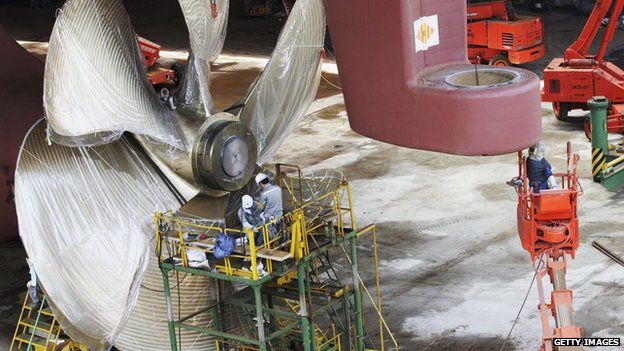
Government direction and government subsidy was the order of the day. South Korea's leader at the time, Gen Park Chung-hee, said "do it" and the corrupt rich he had jailed and threatened had no choice but to create the industries the government decreed.
It was "directed capitalism".
Under Park Chung-hee, scores of businessmen were arrested and charged with "illicit profiteering".
Property was confiscated. Some were paraded with signs round their necks saying: "I am a corrupt pig."
In return for freedom and renewed access to their money, the country's richest people were told to invest in new industries.
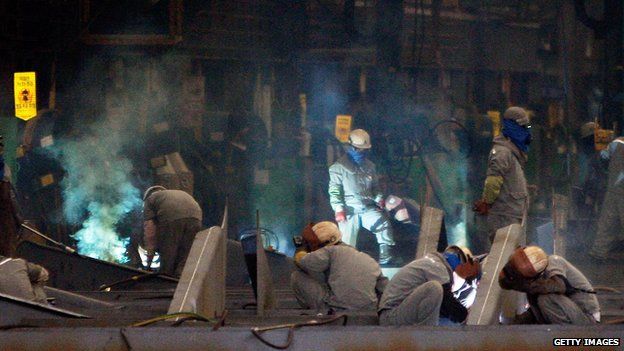
They had to sign an agreement stating: "I will donate all my property when the government requires it for the construction of the nation."
Initially, the plan focused on six key industries (cement, synthetic fibre, electricity, fertiliser, oil refining and iron and steel), but in the early 1970s it turned to shipbuilding.
And this is where construction magnate Chung Ju Yung came in.
It should be said that he was not in that first wave of corrupt business leaders. He earned his money the hard way, born a peasant who left home to labour on building sites and then to form his own construction company.
With the Korean War, he thrived.
Metal bashing
Initially, he made cars in Ulsan but then turned to shipbuilding. He was supremely ambitious and supremely confident - legend has it that he toured London seeking finance and when it was pointed out that South Korea had no shipbuilding industry, he took out a Korean bank note on which was a famous ship from the 16th Century.
He was also supremely careful with money. In the company museum at the Ulsan shipyard, there are two pairs of shoes which Mr Chung is said to have worn for 30 years, getting them constantly repaired despite being a multi-billionaire.
His parsimony has paid off. It used to be said that Asian manufacturers competed with Europeans and North Americans on price but not on quality.
That is no longer so. The Ulsan yard is a builder of sophisticated vessels into which goes a lot of top research.
Metal gets bashed but lab mice get pushed, too. It is heavy industry in which research and the latest technology is incorporated.
Lee Sang-bok is now an inspector at the yard. His role is important.
Some of the vessels built there are carriers of liquefied natural gas. Inside these ships go huge containers. A leak of LNG would be catastrophic, igniting a huge explosion, so welds have to be inspected in microscopic detail. This is what Mr Lee does.
It is a working life that has lasted 40 years. It has given him and his family prosperity and pride.

No comments:
Post a Comment